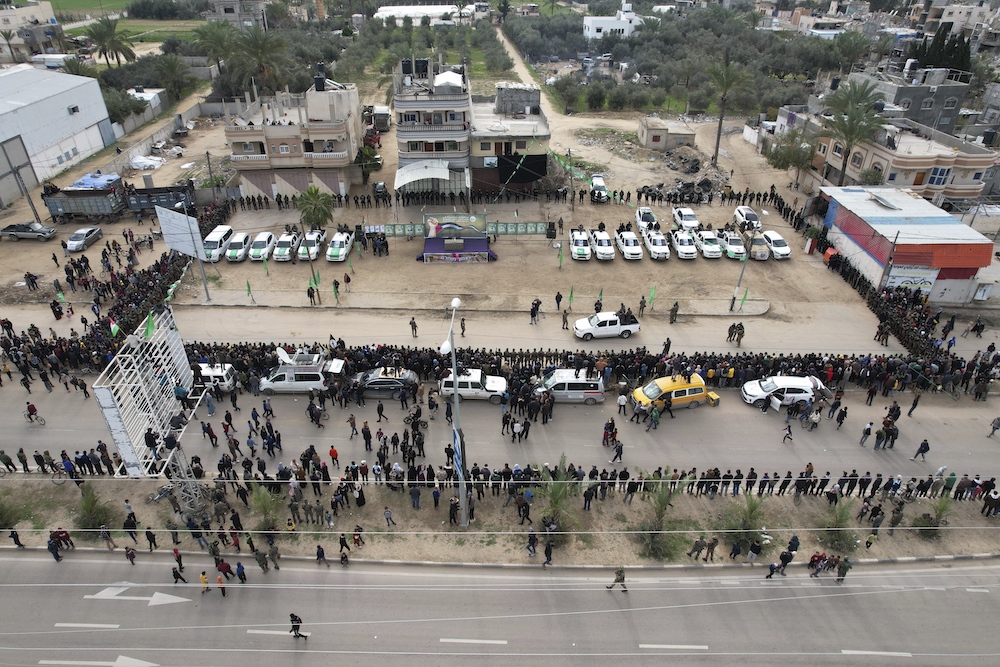BEIRUT: Lebanese Prime Minister Najib Mikati stressed the need to tighten control over the border and distance Lebanon from the repercussions of the developments in Syria on Sunday.
Mikati discussed the situation at the Syrian border in a call with Gen. Joseph Aoun, head of the Armed Forces, and other security chiefs.
Lebanon currently hosts around 2 million Syrians, while more than 800,000 are registered with the UN. Many fled Syria after its civil war began in 2011.
Mikati called on the “Lebanese people, of all affiliations, to show wisdom and avoid provocations, especially at this critical time for our country.”
He urged communication with the National Commission for the Missing and Forcibly Disappeared in Lebanon and the committee addressing the issue of Lebanese detainees in Syria.
He requested the use of all available resources to contact the relevant parties for the release of hundreds of prisoners in Syrian prisons.
Recent developments in Syria, including the opening of prisons by opposition factions and the release of all detainees, along with videos on social media showing alleged Lebanese prisoners previously considered missing, have sparked widespread anger in Lebanon.
On Sunday, Lebanese citizen Marwan Nouh, who had been imprisoned in Syria, returned to Arsal, Lebanon.
The president of the Committee of Families of the Kidnapped and Disappeared in Lebanon, Wadad Halwani, called on Lebanese authorities to follow up on this issue, especially since Syrian officials had long denied the presence of Lebanese prisoners in Syrian prisons.
In Tripoli, Sidon, and parts of Beirut, people celebrated the fall of the Syrian regime.
The Lebanese Army Command took security measures “to prevent any threat to civil peace.”
Social media activists circulated a video showing a group of Lebanese youth storming the Arab socialist Baath party’s office in Akkar, northern Lebanon, and removing posters of Syrian President Bashar Al-Assad.
Also on Sunday, many pro-regime Syrian families, along with Lebanese families who had been living in Syria, namely in Rablah and surrounding villages, entered Lebanon.
Hezbollah in Bekaa sent out a message urging the residents of the pro-Hezbollah Baalbek-Hermel region to welcome them.
Amid these developments, an Israeli airstrike hit the eastern ridge between Qoussaya and Anjar.
Early on Sunday, hundreds of Syrians gathered at Masnaa Border Crossing with Syria, waiting for the Lebanese General Security’s to open it.
Many more closely followed the rapid military developments in their homeland through television and social media.
Around 400,000 Syrians returned home from Lebanon during the Israeli assault on southern Lebanon, which lasted for 64 days.
In Arsal, a border town in eastern Lebanon whose terrain overlaps with Syria and includes the most significant number of Syrian refugee camps, people emerged from their tents at dawn and began chanting enthusiastic slogans.
One camp official, Abu Mohammed, told Arab News that people had not slept.
“We toured these camps in the Qalamoun region, Qusayr, and its countryside. All the people want to return, but we look forward to an orderly exit from Lebanon.”
He said that the refugee committees submitted a request to the relevant authorities in Lebanon to inquire about the procedures for return.
“We have been informed that those wishing to leave Lebanon may do so only once without possibly returning.
“Departure can occur through Al-Zamrani crossing on the outskirts of Arsal, a natural geographical passage and not an official crossing, or via Al-Matraba crossing in Hermel, an unofficial route.
“The former leads refugees to Qalamoun, while the latter directs them to Qusayr.”
The General Directorate of General Security in Lebanon said it would provide all necessary facilities to return Syrians to Lebanon.
It noted that the repeated Israeli assaults on the land border crossings, particularly in the north, have led to the closure of these crossings until further notice to ensure the safety of travelers and entrants.
Consequently, Masnaa Border Crossing remains open for the place of entry and exit, especially for Syrian nationals, under the previously issued temporary exceptional measures and instructions.
As of Sunday afternoon, around 1,500 Syrians crossed from Lebanon into Syria at Masnaa Border Crossing.
Conversely, the crossing experienced a significant influx of Syrians entering Lebanon, either to utilize Beirut Airport for travel or due to having residency permits or sponsors under the procedures established by Lebanon.
The Military Operations Management in Syria confirmed the withdrawal of Hezbollah from Al-Qusayr and Homs towards Lebanon.
The Lebanese Armed Forces announced the deployment of reinforcements to the Lebanese border north of the town of Al-Qaa following reports of the evacuation of Syrian security and customs personnel from their positions.
Dalal Harb, the spokesperson and Communications Officer for the UN High Commissioner for Refugees, told Arab News about the measures UNHCR can implement to facilitate the return of Syrian refugees from Lebanon to Syria.
She said it is aware of reports of Syrians returning from Lebanon, with some movements reported through Masnaa crossing in Bekaa.
According to the Lebanese General Security Office, measures have been announced to facilitate returns to Syria.
Harb said: “We closely monitor these developments and remain in contact with the relevant authorities. Updates will be provided as more information becomes available.”
























